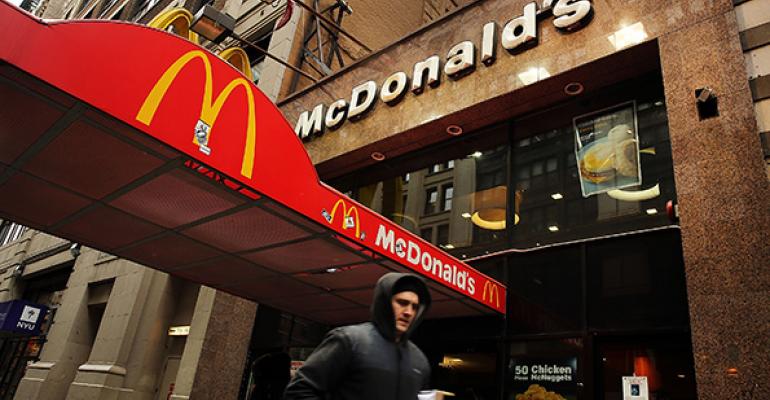McDonald’s Corp. announced plans Monday to streamline its operations and sell more units to franchisees, during its eagerly anticipated turnaround plan announcement.
But in response, Wall Street yawned. McDonald’s stock fell about 1 percent after the announcement, and some analysts suggested that investors wanted more.
Still, the announcement illustrates that McDonald’s turnaround from a two-year sales slump will be neither easy nor quick. The 36,000-unit operator has more than $80 billion in annual systemwide sales. Its problems vary by market and complexity.
McDonald’s CEO Steve Easterbrook suggested that the announcement represented just the first step in the company’s plan, and that more is forthcoming.
“We have only been in place for two months,” Easterbrook said during a call Monday with analysts. “I’ve been very clear that my No. 1 priority has been to address operational issues.”
“These are the initial steps,” he said during a conference call with reporters that followed. “There’s more to do and more to come.”
McDonald’s is working to reverse a difficult sales trend, particularly in the U.S., where guest counts fell by 4.1 percent in 2014, and sales have continued to weaken in 2015, including a 2.6-percent same-store sales decline in the first quarter. But the operator has also had problems in Europe and Asia. Many of these issues are unique to their own markets.
This has pressured the company to make broad changes. And indeed, recent months have seen a steady parade of announcements from the Oak Brook, Ill.-based company, including layoffs, Easterbrook’s appointment to the CEO post, the closing of 350 restaurants, and numerous product and service initiatives.
Andy Barish, analyst with Jefferies, suggested that the task ahead of Easterbrook will not be easy, and certainly not as easy as the one the company unleashed in 2003, which led to a decade of extraordinary growth.
“We believe this time it will be a bit more challenging given the rapid changes in the consumer and competitive landscape in the U.S. and potential brand perception challenges internationally,” Barish wrote in a note Monday. He said near-term operating results will likely be weak, and the turnaround plan “will take time before results are realized.”
Likewise, Baird analyst David Tarantino said in a note Monday that, “Progress on restoring positive operating momentum could be gradual.”
McDonald’s announcement Monday included a plan to sell 3,500 of its 6,700 restaurants by 2018. That is more than the 1,500 restaurants the company currently plans to refranchise, and would leave it with 90-percent franchise ownership.
The restaurant sales would seemingly assuage at least some investors who want to see McDonald’s franchise more units and operate fewer. Franchising generally is more profitable than ownership, and franchise restaurant investors have been pushing companies in that direction for years.
Reorganization could drive even bigger changes
Executives stressed that they remain committed to operating company-owned restaurants because they enable the company to lead the system, test products and develop future leaders. Yet they also suggested that they could be open to further refranchising after 2018.
“This is just a point in time,” Easterbrook told analysts. “2018 is not when the world ends.” He suggested that McDonald’s would reassess its company-owned restaurant structure afterward.
Easterbrook noted that during his time overseeing McDonald’s UK operations, starting in 2006, the company went from 35-percent franchised to 65-percent franchised.
“That was just a real strong contributor to driving energy” into the brand, he said. “I have a strong, philosophical commitment behind franchising. It’s incredibly important to our business.”
The reorganization could drive even bigger changes. The effort would realign McDonald’s global structure, so markets are organized not by geography but by their state of growth: The U.S. would be its own division; established markets like Australia, the U.K., France, Canada and Germany would be their own division. High-growth markets would be organized under a division, and the remaining markets would be lumped into a fourth division.
“I have introduced a structure I believe fit for our purpose in the future, and which challenges the legacy structure I inherited,” Easterbrook said.
The idea would be to simplify the company’s organizational structure and reduce bureaucracy, enabling faster decision-making. The new organizational structure will be in place by July.
“There’s no doubt in my mind that McDonald’s has built a powerful and enduring economic advantage over the decades,” Easterbrook said. “We have more capital, more firepower than any other restaurant business in the world. The reality is, our recent performance has been poor.”
Combined, refranchising and the reorganization could save $300 million in general and administrative spending, with most of that realized by the end of 2017. That likely portends to further layoffs.
“There will be an impact on headcount,” Easterbrook said, stressing that the company plans to put the “greatest talent in the most influential positions” and put the “best teams into major markets.”
The company largely left out discussions on other topics, notably any new menu news or any discussion about its vast real estate holdings. But executives suggested they’re at least willing to look at a possible spinoff of the company’s real estate, something the company has long resisted.
“We’ll continue to evaluate opportunities to further enhance value for all shareholders,” Easterbrook said, noting that it’s “incumbent on us to reassess decisions made previously.”
Easterbrook suggested that customization would be part of McDonald’s future, but whether that looks like the extensive Create Your Taste platform or the toned-down TasteCrafted platform remains to be seen.
Create Your Taste is a dine-in platform using touchscreen kiosks, and is popular in Australia. TasteCrafted is a limited version that could be available at the drive thru and by existing means. Both tests are ongoing in the U.S.
“We’ll let them both play out,” Easterbrook said. “We’ll see the benefits and let that guide future decision making.”
Contact Jonathan Maze at [email protected].
Follow him on Twitter: @jonathanmaze

